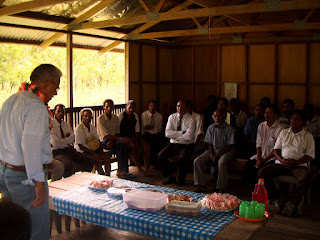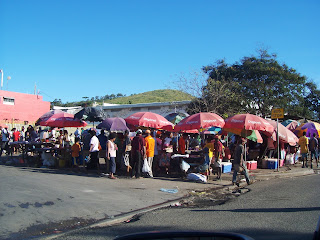My purpose in going to PNG was to meet with several people and visit several locations regarding possible humanitarian aid opportunities. Right from the start, you all should know that there are more opportunities than there are resources – so why the visit? Well, it is just like giving away scholarships – any student will take one, but only a few will actually work for them. It was my intent to determine who would be willing to work for the assistance we are interested in giving.
Our key objectives are to:
• Relieve the suffering of the poor and needy.
• Help them help themselves be more self-reliant.
• Assure sustainability.
• Exemplify the teaching of our Master, Jesus Christ.

Our first stop was to meet with the leaders of a village many miles south of Port Moresby, a place called Gabone. There we meet in the LDS Church building. We had more than 30 men in attendance. We discussed their needs and how we could help them.
The sisters from the Church brought a few light refreshments. They also made lays for each of us.

Following the meeting each person in attendance came up and introduced themselves to me and told me their “story.” And each one had a story to tell. There was a good feeling there. They are limited as to how much they can cultivate in the family gardens, because of how much time it take to cut back the jungle between rain storms. If they had power implements they could plant and thus harvest more. They want to do that.

Like in the Solomon Islands, most of the homes in PNG are built up off the ground. They use whatever materials they can find, trade, borrow, or steal to build their homes.

This small home is built with a sturdy foundation of native logs and a good roof of corrugated steel. Look how neat they keep their yards – out in the bush.

Most of the homes I saw appeared to have been finished as materials became available.

The LDS Chapels stood out everywhere we went as the cleanest and best maintained of all the buildings around.

Even in the bush, the LDS Chapels were clean, well constructed, and well maintained.

For the most part, even the grounds were well planned and cared for. All of the Church facilities were examples of our desire to be the best we can and present to the Lord the best we have.

However, not even the LDS Church facilities were exempt from the ravages of crime and corruption. Every place we went to was fenced, gated, and guarded. Here the LDS Church property has a large gate that remains closed at all times, a tall fence with razor wire along the top and 24-hour security protection.

Burglary and theft were not the only concerns, although they were a constant threat, vandalism and graffiti were present everywhere I looked.

It seemed that there was hardly a single vertical surface anywhere that wasn’t marked up.

High walls and fences seemed to be the only way to survive in this country of lawlessness. Some property owners commissioned their walls to have murals painted on them. The gangs and vandals seemed to respect that and not tag over it – for some reason.

This security wall had a wrought iron fence in front of it which helped to kept it from being tagged. At the top, between the pickets and the steel wall, is rolled razor wire. This was common for all residential properties and many businesses in and around Port Moresby.
The stands in front of the security wall/fence are used to place their garbage in. It keeps it off the ground an away from dogs and rodents.

The one place we didn’t see high walls and razor wired fences was around the community built our over the water in the bay.

This picture and the few that follow are of the local market place. I did venture to go into this one, but most of them were far too dangerous for a pail skinned foreigner.

Most of the markets were crowded with people – vendors, shoppers, robbers, gangsters, etc. – all crowded under a sea of umbrellas.

One could find anything from home sewn dresses, to jewelry, art and crafts, fruits and vegetables, to wrist watched – both new and “slightly used.”

Even small bundles of firewood were sold along the streets. Some of the vendors build fires right in the open market to cook their food – either to eat or to sell.

Not everyone in Port Moresby is living in poverty. This is a picture of the Central Business District. High-rise office buildings, hotels, and apartments are every bit as nice as you would find anywhere else. What is missing is the middle case. They are almost non-existent. We ate a few of our meals at these hotels – YUMI (as they say in pigeon).

Our purpose in going to PNG was to check out several opportunities for humanitarian aid projects. In keeping with that we met with the Minister of Development, Dame Carol Kidu and her right-hand Directors. We had a delightful visit and were able to discuss her priorities – which are the rights and care of the children, the rising generation.

As in the Solomon Islands, I spent considerable amount of time at the main hospital. This is a picture of the ICU/CCU. While they did not have a central monitoring station, it gave the appearance of being well equipped and staffed.

The general wards of the hospital were not quite as well equipped or staffed. Notice the family members sleeping on the floor under the patient beds.

All of the wards we visited had 56 beds; two rows of 14 beds on each side of a long hall. They were being cared for by two nurses, supplemented by family members (who are, incidentally, the primary care givers).

The Accident Emergency Department (A & E) was overflowing with patients and visitors. There were many similarities to the ER at Ben Taub Hospital in Houston – especially when it came to long wait times and over-crowding.

This is their minor surgery room. They didn’t have a surgical table so a local carpenter built this one of wood and plastic laminate. The OR light didn’t function.

This is their cardiac and high-risk observation room. Notice the parents caring for their dehydrated infant on the floor.
We visited with the Hospital CEO, but our observation was that the A&E Director was the only staff member with an active plan for improvement. A graduate of the University of PNG, he was a breath of fresh air.
While the hospital is decades ahead of the Solomon Islands hospital, it still is not what it used to be. The Minister of Health explained to us the most of his physician administrators simply did not know how to manage. They were good clinicians, but not good administrators. That appeared to be the case as we saw it.
That being said I thought there were several areas that could benefit immediately from our humanitarian assistance. These I will take back with my recommendations.
1 comment:
I can't stand to see - or hear of - babies who suffer in such circumstances! Or to think of the poor parents, in this case, caring for their struggling child on the floor of a crowded hospital room. (Is this what we face now with ObamaScare?)
Post a Comment